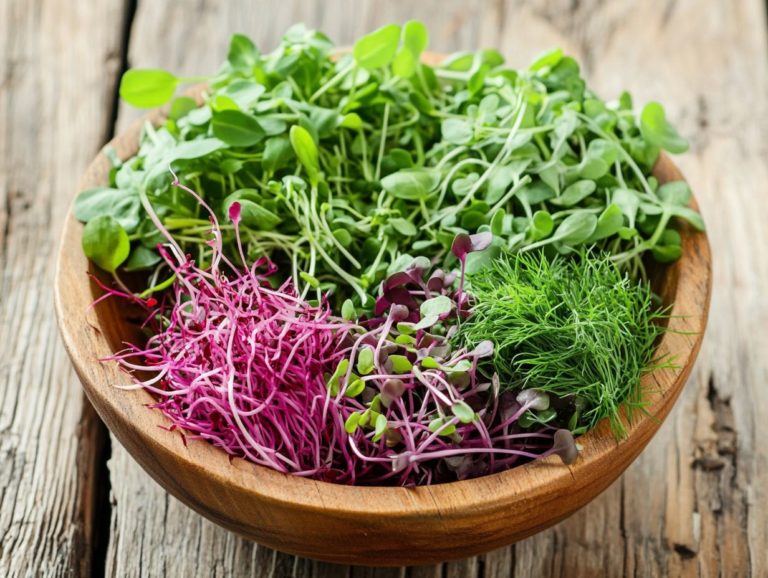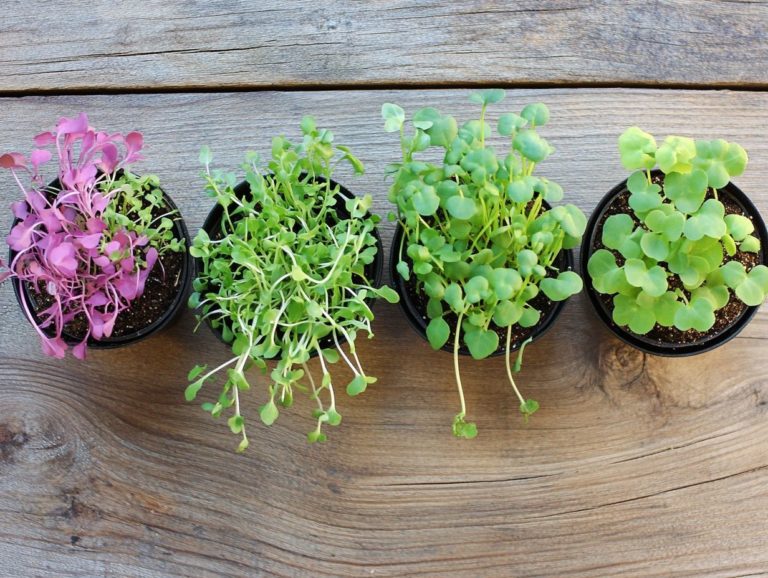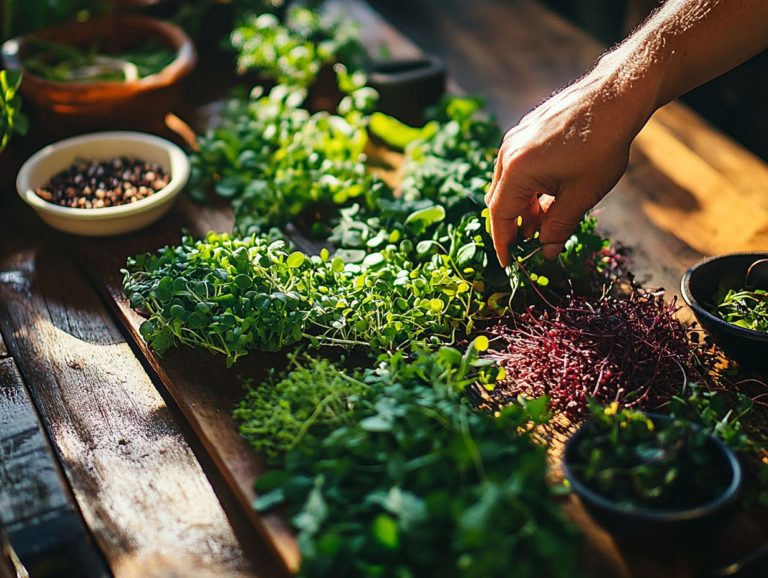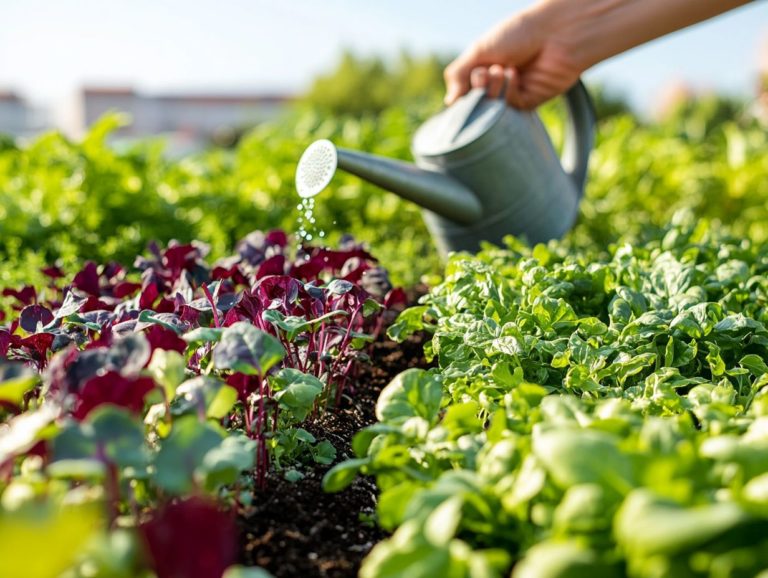Cooking with Microgreen Varieties: Tips and Tricks
Microgreens are tiny, nutrient-dense greens that deliver an impressive burst of flavor and health benefits. Get ready to explore these miniature marvels that not only enhance the taste of your dishes but also provide essential vitamins and minerals, opening up a world of culinary possibilities. Incorporating microgreens into your meals can elevate the nutritional value while adding flavor.
In this article, you will discover the different types of microgreens, their nutritional advantages, and innovative ways to incorporate them into your cooking. You’ll also find tips on proper handling and guidance on growing your own microgreens, ensuring you have fresh microgreens at your fingertips.
Prepare to elevate your meals with these vibrant greens!
Contents
- Key Takeaways:
- Benefits of Cooking with Microgreens
- Types of Microgreens for Cooking
- Tips for Cooking with Microgreens
- Creative Ways to Use Microgreens in Cooking
- Growing Your Own Microgreens for Cooking
- Frequently Asked Questions
- Curious about microgreens? Here s why they re a game-changer in cooking!
- What varieties of microgreens are best for cooking?
- How can I incorporate microgreens into my cooking?
- Do I need to wash microgreens before cooking with them?
- Are there any special cooking tips for using microgreens?
- Can I grow my own microgreens at home?
Key Takeaways:
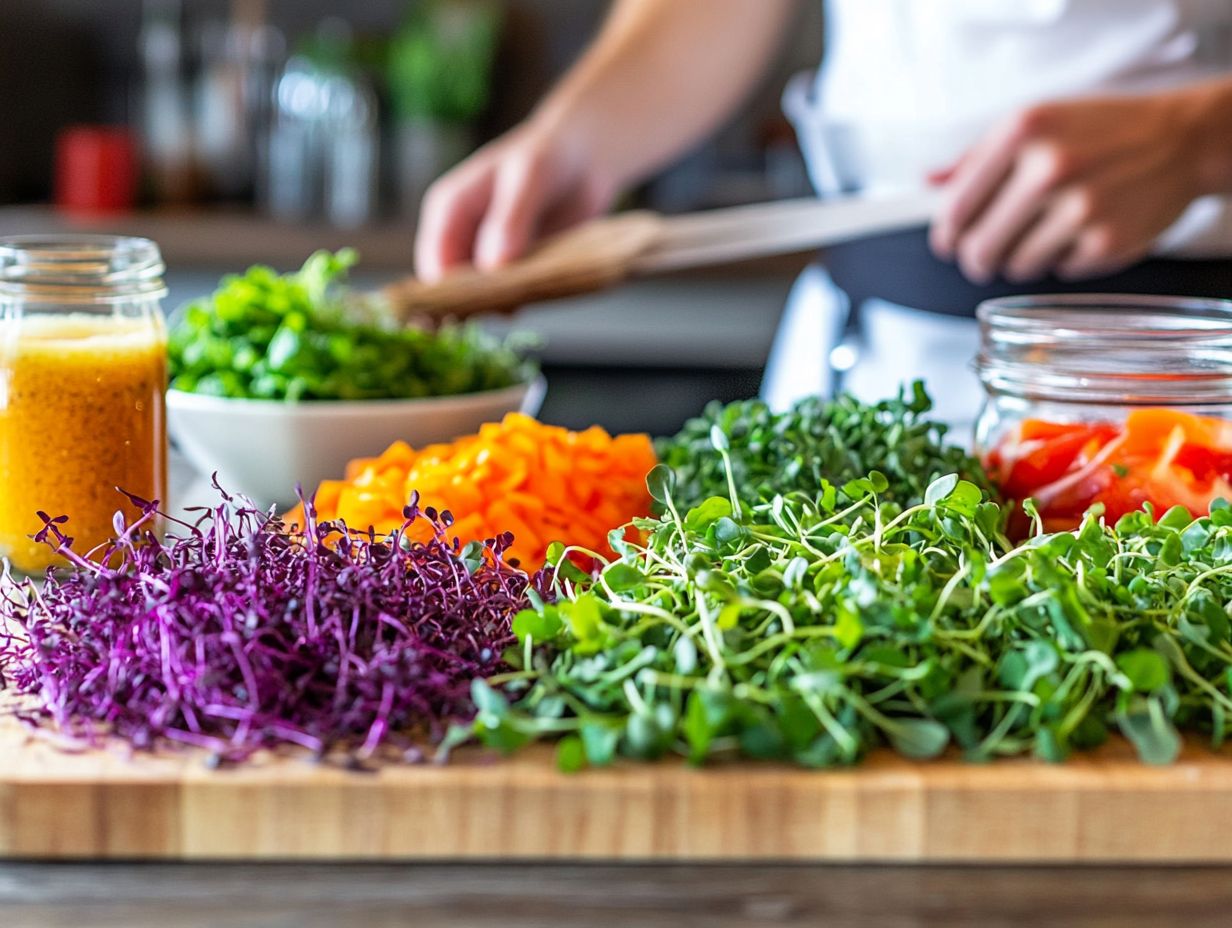
- Microgreens are tiny versions of mature plants that are packed with nutrients and add a burst of flavor to dishes, making them perfect for salads, tacos, and sandwiches.
- Cooking with microgreens can enhance the flavor and nutritional value of your meals, making them essential ingredients in microgreens recipes.
- Proper handling, creative incorporation, and growing your own microgreens are key tips for cooking with these versatile and beneficial ingredients.
What are Microgreens?
Microgreens are young, edible plants harvested just after the first true leaves emerge. They deliver a delightful burst of flavor and nutrition that elevates an array of dishes.
These vibrant greens range from the zesty kick of arugula and the aromatic notes of basil to the mild crunch of radish and the striking hues of purple cabbage. They transcend mere trends and stand as nutrient-rich foods. Packed with antioxidants and essential vitamins A, C, E, and K, as well as vital minerals like calcium and iron, microgreens offer significant health rewards that support a microgreens diet.
The diverse varieties of microgreens can transform even the simplest meals. You can sprinkle them atop a sophisticated entr e or layer them into a microgreens sandwich. They also serve as a vibrant garnish for soups and appetizers, providing an extraordinary burst of flavor and texture.
Their versatility makes microgreens an invaluable ingredient for both chefs and home cooks, inspiring creativity in food presentation and enhancing taste with every bite.
Benefits of Cooking with Microgreens
Cooking with microgreens provides remarkable benefits, from heightened flavor to significant health advantages that transform them into an essential component of your diet, leading to exciting microgreens dishes. These small greens are full of nutrients and antioxidants. They help boost your overall health and well-being.
Incorporating microgreens into your recipes be it in salads, soups, or as toppings for sandwiches enables you to elevate the flavor profile of your dishes effortlessly. Their concentrated taste allows you to enhance flavor without piling on excess calories, making them perfect for those who are health-conscious and eager to improve their meals using microgreens.
Nutritional Value and Flavor Enhancement
Microgreens are not just a feast for the eyes; they also pack a nutritional punch, often boasting higher concentrations of vitamins and minerals than their fully grown counterparts. Take beet and sunflower microgreens, for instance rich in vitamins C, E, and K; they re perfect for elevating the health benefits of your microgreens salads and other dishes.
Beyond their impressive nutritional profile, microgreens inject a burst of flavor that can turn ordinary meals into extraordinary culinary experiences. Whether you sprinkle them on tacos, layer them in sandwiches, or use them as a garnish for soups, they enhance your dishes significantly. If you’re interested in learning how to grow your own, check out this guide on how to grow microgreens for beginners.
Broccoli microgreens, another popular choice, are loaded with sulforaphane, a compound that may help detoxify the body and reduce inflammation. Pea shoot microgreens bring a fresh, sweet crunch that pairs beautifully with savory dishes, while radish microgreens add a spicy kick for those looking to elevate their culinary creations.
When you thoughtfully incorporate these nutrient-dense gems, you re not just enhancing your health; you re also creating a vibrant culinary palette that invites both home cooks and chefs to explore new flavor profiles and textures.
Types of Microgreens for Cooking
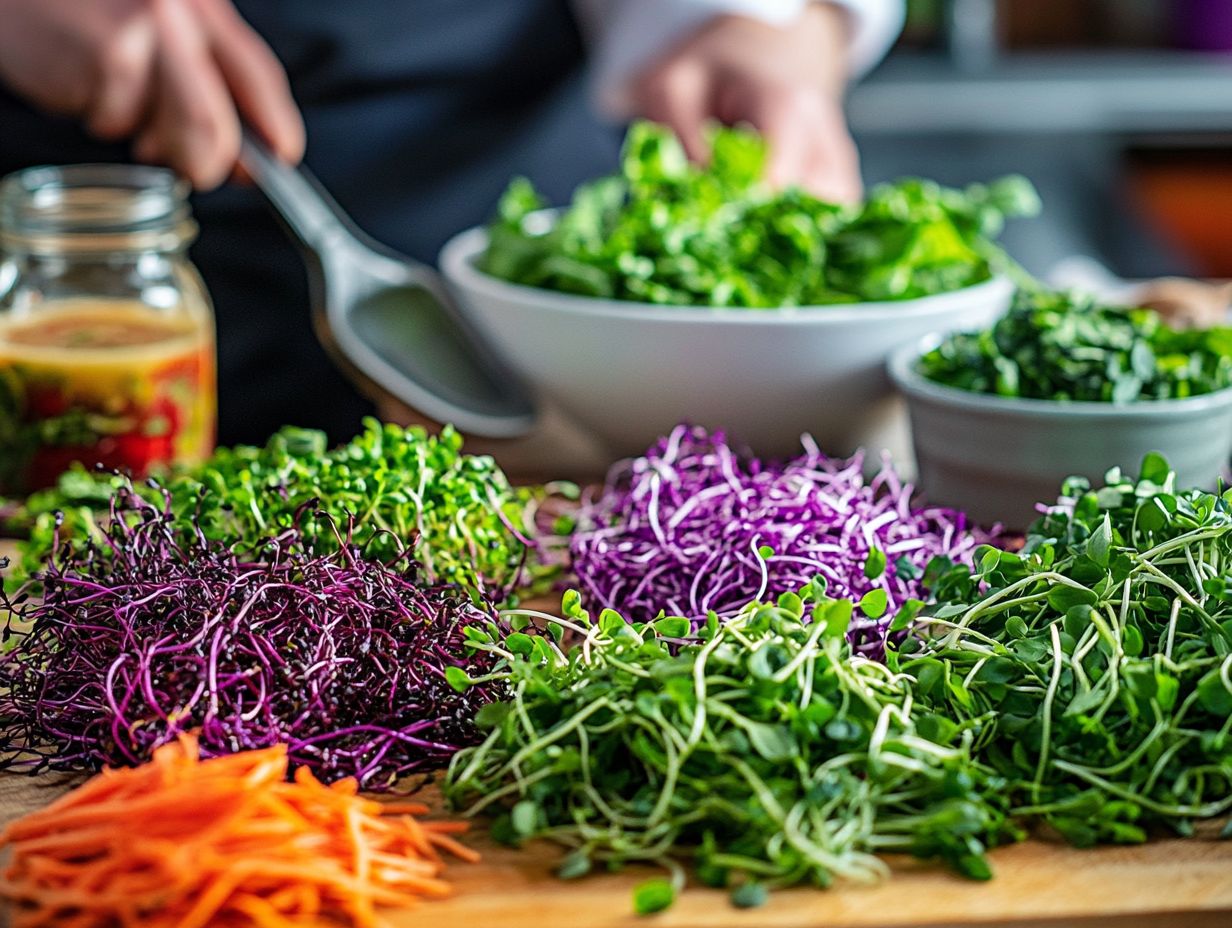
Microgreens offer a world of distinctive flavors. They can elevate your dishes and make meals more versatile.
Sunflower shoots, pea shoots, and lemon basil are just a few popular varieties, each contributing unique tastes to salads, sandwiches, and even beverages. By understanding the nuances among different microgreens, you can choose the perfect ones for your recipes. This enhances both the visual allure and flavor profile of your meals while utilizing ways to enhance flavor in microgreens.
Embracing a variety of microgreens opens the door to exhilarating new creations. You can make tantalizing microgreens tacos or vibrant microgreens salsas that enhance both taste and presentation.
Popular Varieties and Their Uses
Popular varieties like radish, arugula, and basil are celebrated not just for their vibrant colors, but also for the distinct flavors they bring to various dishes.
These tiny greens pack a powerful punch. For instance, arugula microgreens have slightly bitter and nutty notes, elevating the flavor profiles of pizzas and bruschettas. They also make a delightful garnish for creamy soups.
Cilantro microgreens are renowned for their refreshing taste and can enhance everything from salsas to Asian-inspired stir-fries, delivering a burst of freshness in every bite.
Incorporating these microgreens into your meals allows you to experiment and infuse unique textures and flavors. This transforms ordinary plates into extraordinary culinary experiences, including microgreens wraps and microgreens burgers.
Tips for Cooking with Microgreens
Cooking with microgreens is a thrilling adventure! Mastering their handling and preparation can enhance every dish.
Begin by gently rinsing your fresh microgreens under cool water to eliminate any dirt or residue. Pat them dry with a paper towel. To keep their delicate texture and vibrant color, add microgreens at the end of cooking or use them as a garnish, especially in salads and soups.
Understanding how to handle and prepare these little powerhouses will help you unlock their full culinary potential.
Proper Handling and Preparation Techniques
Handling microgreens properly keeps them fresh and flavorful. This is important when adding them to your dishes, such as microgreens soups and microgreens salads.
Store them correctly in a breathable container within your refrigerator’s crisper drawer, where optimal humidity levels are preserved. Microgreens thrive with minimal moisture exposure, so wash them just before use to extend their shelf life.
For slicing, use a sharp knife instead of a dull one. This prevents tearing and helps preserve their delightful aroma. Mastering these techniques will enhance your elegant garnishes and hearty dishes, ensuring each microgreen retains its vibrant taste and visual allure. To explore different options, check out microgreen varieties: a guide for beginners, thus improving your dining experience.
Creative Ways to Use Microgreens in Cooking
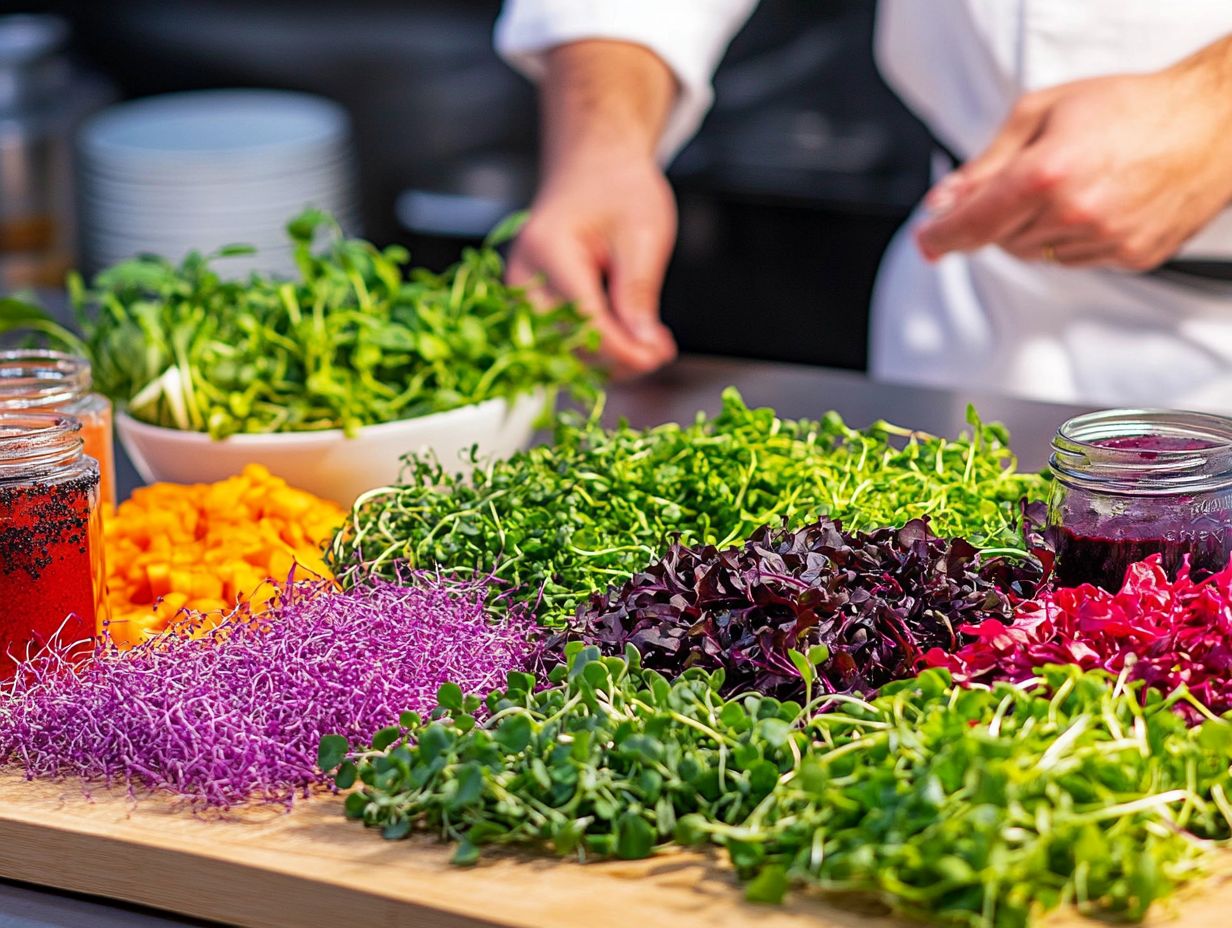
You have countless creative avenues to incorporate microgreens into your cooking. This can elevate everyday meals into gourmet experiences that are both healthful and delightful.
Picture using microgreens as vibrant garnishes for burgers and sandwiches or blending them into smoothies and pesto. To enhance your culinary creations even further, learn how to maximize yields from microgreens. These tiny greens can infuse a burst of flavor into virtually any dish.
Experimenting with microgreen ideas can inspire you to craft unique combinations, like microgreen tacos brimming with fresh ingredients or salads that showcase seasonal vegetables. Your culinary adventures will become even more exhilarating with these versatile ingredients.
Try out these tips today! Discover how microgreens can transform your meals into culinary delights.
Incorporating Microgreens into Different Dishes
Incorporating microgreens into your dishes can truly elevate both flavor and nutritional content, making them an essential ingredient for a variety of culinary creations. Whether you sprinkle them atop soups for a fresh garnish, mix them into salads for that satisfying crunch, or blend them into sauces for an added depth of flavor, the versatility of microgreens opens a world of culinary possibilities! You can even get creative at breakfast with microgreens omelets or smoothies, effortlessly enhancing your meals with essential nutrients.
For instance, imagine using radish microgreens, which add a spicy kick, in a zesty salsa to introduce vibrant color, while pea shoots contribute a sweet taste in stir-fries. These tiny greens can effortlessly be folded into grain bowls, offering a burst of freshness that perfectly complements roasted vegetables and proteins alike, making them great options for microgreens bowls. If you’re looking for more ideas, check out these essential tips for growing microgreens at home.
But it doesn’t stop there; microgreens like sunflower or basil can also enrich desserts. Picture a delicate microgreens-infused panna cotta, showcasing their unique flavors and brilliant colors. To learn more about selecting the best options, check out our guide on how to choose microgreen varieties for your garden. By weaving these nutritious powerhouses into your everyday meals, you can easily boost both health benefits and presentation, transforming simple dishes into something extraordinary.
Growing Your Own Microgreens for Cooking
Growing your own microgreens for cooking can be an immensely rewarding and cost-effective endeavor, ensuring you always have a fresh supply to enhance your culinary creations. With just a few simple supplies and a touch of patience, you can cultivate an array of microgreens, like sunflower and pea shoots, right in your kitchen.
This comprehensive guide will lead you through the entire process, offering essential tips for successful growth from selecting the perfect seeds to creating the ideal conditions for them to flourish.
Step-by-Step Guide and Tips
To successfully grow microgreens, follow this step-by-step guide that ensures you cover everything from seed selection to harvesting, ultimately guaranteeing a bountiful crop for your culinary adventures.
Start by selecting seeds that resonate with your palate, whether it s peppery arugula or fragrant basil. Prepare a shallow tray filled with quality soil or a suitable growing medium. Gently water your seeds and place the tray in a warm, sunny spot to encourage vigorous growth.
Within a few days, you ll witness the delightful sight of microgreens sprouting, and in just a couple of weeks, they ll be primed to add both flavor and nutrition to your dishes.
As they begin to grow, remain vigilant in providing consistent moisture without overwatering, as this can lead to damping off a problem where seedlings can rot if they get too much water. A fine mist spray will help maintain humidity while ensuring that the growing medium drains effectively.
As your microgreens flourish, consider introducing a diluted liquid fertilizer, or a watered-down plant food, to enhance their nutrient profile.
When it s time to harvest, use clean scissors to cut just above the soil line, ideally when the first true leaves emerge, which typically happens at around two to four inches tall. By giving proper care throughout this entire process, you will yield vibrant, nutritious greens that can elevate any meal to new heights.
Frequently Asked Questions
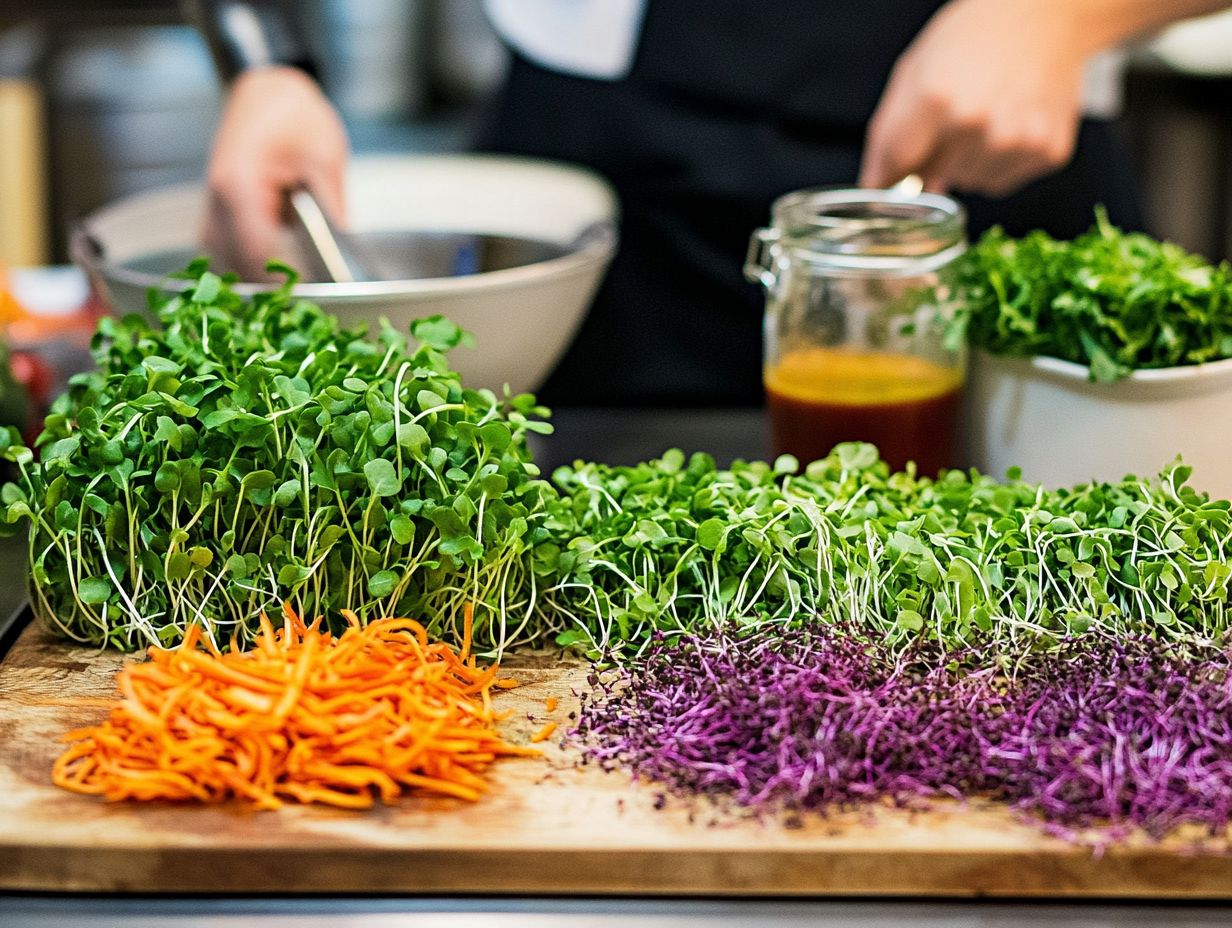
Curious about microgreens? Here s why they re a game-changer in cooking!
Microgreens are young vegetable greens that are harvested at an early stage of growth. They are popular for cooking because they have a concentrated flavor and are packed with nutrients.
What varieties of microgreens are best for cooking?
Some popular microgreen varieties for cooking include arugula, basil, broccoli, kale, and radish. However, you can experiment with different types to find your favorite flavor combinations.
How can I incorporate microgreens into my cooking?
Microgreens can be used as a garnish, added to salads, sandwiches, and wraps, or even used as a topping for soups and pizzas. They can also be incorporated into sauces and marinades for an extra burst of flavor.
Start growing your own microgreens today! You’ll be amazed at the flavors and nutrition they bring to your meals.
Do I need to wash microgreens before cooking with them?
Yes, wash microgreens before cooking. They can carry dirt and bacteria.
Rinse them gently in cold water and pat them dry with a paper towel.
Are there any special cooking tips for using microgreens?
Add microgreens at the end of cooking to keep their fresh flavor and texture. You can also saut them lightly or toss them into an omelet for a tasty breakfast!
Can I grow my own microgreens at home?
Absolutely! Growing microgreens at home is simple with just seeds, potting soil, and a container.
Place your setup in a sunny window or use a grow light for a steady supply of fresh microgreens!

